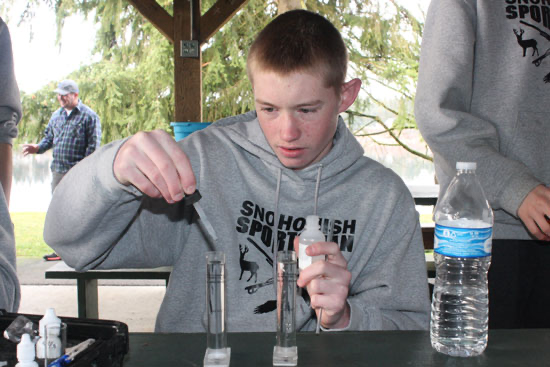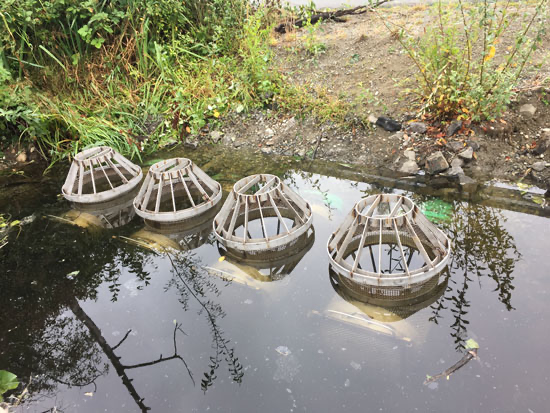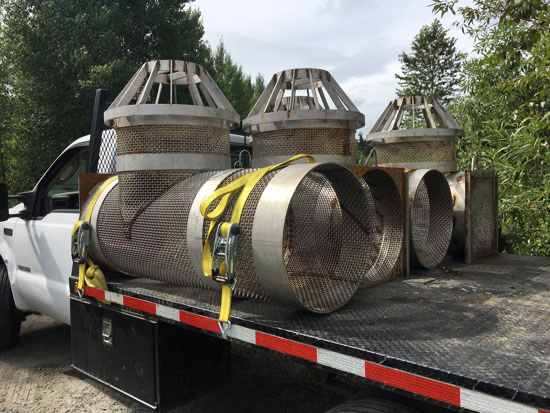The waters of Blackman Lake as seen on a cloudy day in July 2021.
Photo by Michael Whitney.
SNOHOMISH — Blackman Lake is still struggling.
Water clarity is getting murkier. Phosphorous, which robs water of oxygen, is increasing. Some described that Blackman Lake is undergoing a slow, natural process of dying.
Goose droppings and pet feces are the primary pollutants accelerating its decline, with fertilizer runoff being the third assailant.
The city is taking steps to dissuade the geese. Picking up after pets and not liberally spraying fertilizer is upon the public. Pet feces is carried into creeks and ditches that constitute the lake’s watershed. Livestock feces from pastures upstream contribute as well.
Lake health data encapsulates the situation as the eventual death of the lake, termed as eutrophication.
Part of the question is how to slow it down.
A pact of lakeside neighbors called Friends of Blackman Lake petitioned the city last month to comprehensively act. One step is forming a city-level workgroup about the lake, they say.
“Citizens are assuming it’s being taken care of, but it’s not,” Kay Ditzenberger, a co-leader of the Friends group, said in an interview.
County water experts monitor the lake monthly under a contract with the city. Routine analysis work on the lake’s health traces back at least into the 1990s.
Fertilizers enrich the lake water with phosphorous and nitrates. Ditzenberger says neighbors over-fertilize their lawns.
Fragrant water lilies, an invasive species to Blackman Lake, are decomposing and adding silt to the lake bed, making the lake shallower, Snohomish County Surface Water Management Water Quality Specialist Marisa Burghdoff said.
The lake’s watershed extends as far north as 56th Street SE. The only outlet is Swifty Creek, which carries water south to the Snohomish River.
What phosphorous washes in, it doesn’t quickly wash out through circulation. It often settles into the lake, Burghdoff said.
The county doesn’t monitor fecal coliform bacteria levels as part of its work.
A Snohomish High School science class conducted fecal coliform testing before, though, using water turbidity tests. They reported findings in December 2018, for example, that their lake samplings showed an average of 566 fecal coliform bacteria colonies per 100 milliliters of water. Washington State standards recommend this level be no higher than 100 colonies per 100 milliliters of water for swimming or 200 colonies per 100 milliliters for wading.

Dan Armstrong file photo
The Junior Sportsmen of Snohomish High disbanded lake testing efforts at the start of the COVID-19 pandemic and haven’t resumed since, according to Friends of Blackman Lake member Kay Ditzenberger.
Ditzenberger asserts it’s unsafe based on those prior water quality tests. “The lake should be closed as it stands right now,” Ditzenberger said.
“It’s not a clean lake, it’s a dirty lake,” neighbor Marci Gionet told the City Council in August.
The Snohomish Health District is who has that authority, Burghdoff said.
The fecal coliform bacteria in the lake is most likely the geese, Burghdoff said.
Geese droppings also are full of nitrates and phosphorous.
The city acted to dissuade geese before. They added a five-foot buffer of salal shrubs and similar native plants along the lakefront to make the area unfavorable to geese. No similar future projects are planned, city engineer Yosh Monzaki said. He is the city’s liaison with the county on Blackman Lake’s quality.
The invasive lilies can be controlled with herbicides, and they are. Sprays are heavily regulated under a permit.
The permit allows spraying controlling algae blooms and noxious and nuisance weeds with certain chemicals, said Colleen Keltz, a state Department of Ecology spokeswoman for water quality issues. Floating lilypads can be killed including the aquatic formulation of glyphosate. One not allowed is Roundup, a formulation of glyphosate unsafe for waterways.
The lake was treated on July 27. “Of the 61 acre lake, 0.75 acres was treated on July 27, 2021 using 36 ounces of Imazapyr and 12 ounces of Glyphosate,” Keltz said.
The permit rules are strict, requiring notifications in advance and reports on how much was sprayed and where.
It alarms neighbors that posted signs of chemical sprays aren’t prominently large to warn swimmers.
About algae
Lakes contain good algae and bad algae. Algae is the base foundation of a lake’s food chain.
It is the blue-green algae, which can be toxic to people, that prompts public danger warnings when it blooms. Phosphorous-rich water empowers the bad algae to thrive.
Volunteer lake watchers call in reports of algae blooms.
Toxic algae require lab testing to find if toxins exceed state safety guidelines. Every bloom sighting prompts the city to automatically post public warning signs at the lake and publish a news flash on its website, Monzaki said.
Northwest Toxic Algae is commissioned to do the tests, Keltz said. Northwest Toxic Algae’s logs show Blackman Lake saw four such bloom tests in response to algae scum sightings during 2020. Only one case, in October 2020, showed the toxins exceeded state safety guidelines for microcystin, a class of toxin. That sample was taken near the boat launch. At the time it was collected, 20 people were seen wading and five people were fishing, that report says.
The blue-green toxic algae sometimes looks like a paint spill on the water. Non-toxic algae looks like a mat.
You can report a bloom to them: www.nwtoxicalgae.org
But this summer has had plenty of sun, so why haven’t these blooms flourished?
Heat does funny things to the hydrologic properties of the lake: During cold months, oxygenated water circulates in all the water. In warm weather, though, the lake stratifies: Oxygenated water rises to a layer up top, while a layer of oxygenless water falls below, Burghdoff described. The phosphorous falls to the bottom layer and further enriches it.
Trouble is, after summer, the water mixes together again, causing richly fertile water to rise. It can feed the algae.
The last noted toxic algae bloom was in late March of this year.
Burghdoff, the water specialist, bets some blooms will occur this fall.
Septic systems can impact the watershed when they leak, but this does not appear to be factoring in for Blackman Lake. Not many homes are on septic in the area. Most are on sewers. (There haven’t been any sewer leaks recently to Monzaki’s recollection.)
Homes north of 22nd Street are all on septic, Monzaki said.
A lake’s aging is natural. All lakes age, Burghdoff said. Some take hundreds of years.
Slowing the lake aging is through controlling nitrate and phosphorous to let it maintain its oxygen.
Reversing lake aging can actually be done, Burghdoff noted, but it is expensive. The city owns the lake. City taxpayers would be on the hook if it tried.
The city plans to publicly present on the state of Blackman Lake at an upcoming City Council meeting.
Blackman Lake got its name from the Blackman brothers, two giants in the
logging business during Snohomish’s pioneer days of the late 1800s. The Blackman House Museum on Avenue B once was the youngest brother’s personal home.
Help for septic systems
The county has a grant program to help low-income homeowners pay for septic system maintenance. People can get up to $599 covered for maintenance. Go to www.snohomishcountywa.gov/2816/Grants or call 425-388-3636 to learn more about the Savvy Septic program.
— Tribune archives are included in this story
New fish screens installed in 2020

City of Snohomish photos
In 2016, the city installed a berm called a weir to regulate lake levels and prevent local flooding by controlling Blackman Lake’s outflow to Swifty Creek. Fish, though, were exiting the lake into the weir area as a passageway, so the city screened that off to contain the fish in the lake. These screens required regular maintenance to clean debris.
In 2020, the fish screens was redesigned (pictured above underwater). Now the fish screens have underwater pipes that look like an inverted “T” (see above) to let overflow spill out while keeping in the fish. During heavy rains, it won’t flood nearby properties, city engineer Yosh Monzaki said.